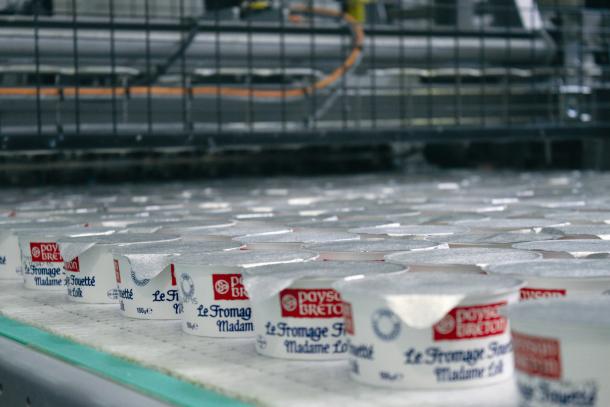To cope with growing volumes for its Madam Loik whipped cheese, French dairy company Laita has automated palletisation on its production line at its Crehen, NW France plant by installing a Cermex Pal-Vite 410 robotic palletising unit downstream from the filling operations.
For the Madame Loïk range, the tubs are hot-filled and cooled by going through a cold room.
In the past, the tubs were transferred from the filler to the cooling unit by conveying them onto an accumulation table at the end of the line, accommodating up to 50 tubs.
The tubs were moved by hand on to metal racks stacked on top of each other on trolleys that were then wheeled to the cooling unit.
To cope with growth in demand for its whipped cheese, Laïta decided to increase its production rate. However, accelerating the manual transfer of tubs onto the racks was discarded for technical reasons, and for the health and safety of operators.
Automation emerged as the best solution for accelerating transfer towards the cooling unit.
For Laita, the challenge was to enable frequent recipe and format changeovers – at least 20 times per day – without automation increasing line downtime; the product accumulation capacity needed to be maintained, so as not to affect the upstream production of the line, in particular by stopping the filler; and the overall organisation of production had to be complied with.
It became clear that automating a second line would reduce the arduousness of the manual work – not only on one – but both lines. It was logically more cost-effective to invest in one unit with two product infeeds, which now manages both of the high-speed lines in the factory.
After filling and sealing, the Pal-Vite 410 two-station robotic unit palletises the cheese tubs layer by layer, with reusable cardboard separators inserted between layers.
It manages the infeed of products on two lanes, coming from the filling machine of each line.
The maximum speed is 15,000 tubs per hour, and the robot can handle up to four different heights of tub, with the possibility of handling two different heights simultaneously.

The unit ensures individual and contactless product handling up to gripping. The gripping tooling equipped with 96 suction cups enables a whole layer to be palletised in one go. With four vacuum zones, gripping of the batch is secured if one product is dropped and partial batch gripping is possible (as little as one tub) in order to optimise runout phases during recipe or format changeovers. The choice of suction cup is adapted to guarantee optimum gripping without marking the cap seals.
The robot as well as the pallet handling and stocking systems are standard, whereas the gripping tooling and the product collating system are customer-specific. The unit has been divided into two zones (product handling/collation and palletisation) so as to enable access and work without interrupting operation of the entire unit.
Cermex, part of the palletising/ depalletising business unit of Gebo Cermex, specialises in robotic palletising units, combining the supply of standard modules with the capacity to develop customised solutions.







